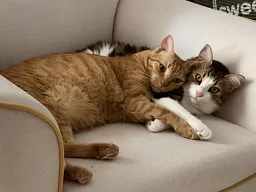
A domestic cat begs for food in a seaside restaurant in Athens, Greece.
Domestic Cat
Species Facts
Domesticated cats have a great variety of coat colors, textures, and patterns. However, the majority of the world’s domestic cats still have some variation of the tabby coat pattern, which is thought to have originated by mutation from the original striped tabby coat of the African wildcat.
- Scientific Designation: Felis catus
- Endangered Status: Not Listed
- Lifespan: About 15 years
- Weight: 2.3-9.0 kg (5-20 lbs)
- Length: 46-51 cm
- Shoulder Height: 20-25 cm
- Tail Length: 25-38 cm
Diet
Domestic cats remain largely carnivorous. They have evolved a simple gut appropriate for raw meat. They also retain the rough tongue that can help them clean every last morsel from an animal bone (and to groom themselves). Their diets vary with the whims of humans, however, and can be supplemented by the cat's own hunting successes. Predation by domesticated cats can have a serious impact on wildlife, especially on islands where the native fauna has evolved in isolation from predators, or where seabirds nest on the ground. Species affected by the domestic cat include rodents and other small mammals, birds, and reptiles.

Two unrelated domestic cats cuddle in an armchair.
Domestication & Distribution
Domestication of the cat began in Egypt, the Middle East, and Europe. Selective breeding of cats began in the late nineteenth century, beginning in Britain and coinciding with the surge in public interest in the newly introduced theory of evolution and with the widespread fascination with the idea of improving and enhancing different breeds of animals.
The domestic cat’s distribution now covers nearly every corner of the globe.
Behavior
The behavior and instincts of the domestic cat resembles that of the other species of Order Felidae. Like their wild relatives, domestic cats are natural hunters, able to stalk prey and pounce using sharp claws and teeth to make a kill. They are particularly effective at night, when their light-reflecting eyes allow them to see better than can much of their prey. Cats also have acute hearing. Cats communicate by marking trees, fence posts, or furniture (!) with their claws or their waste. These scent posts are meant to inform others of a cat's home range. House cats employ a vocal repertoire that extends from a purr to a screech. As are their wild counterparts, domestic cats are nimble and agile. Their long tails aid their outstanding balance.
Folklore has long maintained that cats always land on their feet. This is TRUE. Cats do indeed right themselves during a fall from a building or a ledge. They turn their legs downward and extend their limbs outward, their position resembling that of a flying squirrel or a gliding position. This saves them from hitting the ground headfirst and changes the aerodynamic drag, slowing down the cats’ body so that it hits the ground with the least possible force.
Do You Have 2-4 Hours A Month To Preserve Your Local Ecosystem?
Our volunteers are the driving force behind making true change in ecosystem health and wild cat conservation. Some like to volunteer in the field, others help us maintain our online presence, and some work with events. With just a few hours a month, you can make a difference, too.
Make A Difference Right Now
As a 501(c)3 nonprofit, our work is only possible because of generous donors like you.
More than 90% of your donation will go directly to our groundbreaking research, outreach, and education programs.
This is where true change starts. If you’d like to be a part of it, make a donation to Felidae Conservation Fund today:
Or,
